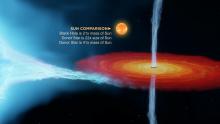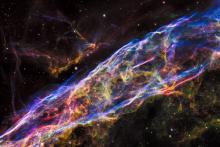Listen to today's episode of StarDate on the web the same day it airs in high-quality streaming audio without any extra ads or announcements. Choose a $8 one-month pass, or listen every day for a year for just $30.
You are here
Jewel Bug
NGC 7027 is blowing itself apart. A dying star has ejected its outer layers into space, surrounding itself with a colorful cocoon of gas and dust. That’s earned the nebula a nickname: the Jewel Bug, after a small insect with a beautiful shell. But the nebula won’t last long. It’s expanding into space. And it’s being eroded by jets of gas from the star.
NGC 7027 is about 3,000 light-years away, in Cygnus. As night falls it’s low in the northeast, below Deneb, the swan’s brightest star.
When the star at the center of the nebula was born, it was several times the mass of the Sun. At the end of its life, the nuclear reactions in its core began to shut down. As a result, the star sloughed off shells of gas from its surface. The shells are expanding into space.
Then not much more than a thousand years ago as seen from Earth, the star began ejecting a lot more gas — and much faster — creating a thicker cloud. And high-speed “jets” of gas appear to be shooting away from the star, punching through everything else.
So today, the nebula looks like a series of rings around a pillow, with spikes from the pillow’s ends. A companion star may be helping to sculpt those shapes. But it’s also possible that the dying star has already swallowed the companion.
Before long, the dying star will shut down. It’ll become a white dwarf — a hot but tiny corpse. Its cocoon will drift away into space — and the Jewel Bug will disappear.
Script by Damond Benningfield





